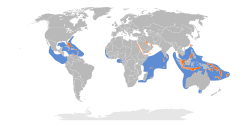| Bridled tern | |
|---|---|
 | |
| Adult on Lady Elliot Island, Australia | |
| Scientific classification | |
| Kingdom: | Animalia |
| Phylum: | Chordata |
| Class: | Aves |
| Order: | Charadriiformes |
| Family: | Laridae |
| Genus: | Onychoprion |
| Species: | O. anaethetus |
| Binomial name | |
| Onychoprion anaethetus (Scopoli, 1786) | |
 | |
| Synonyms | |
Sterna anaethetaScopoli, 1786Sterna anaethetusScopoli, 1786 Contents | |

The bridled tern (Onychoprion anaethetus) [2] [3] [4] is a seabird of the family Laridae. It is a bird of the tropical oceans. The scientific name is from Ancient Greek. The genus comes from onux meaning "claw" or "nail", and prion, meaning "saw". The specific anaethetus means "senseless, stupid". [5]









